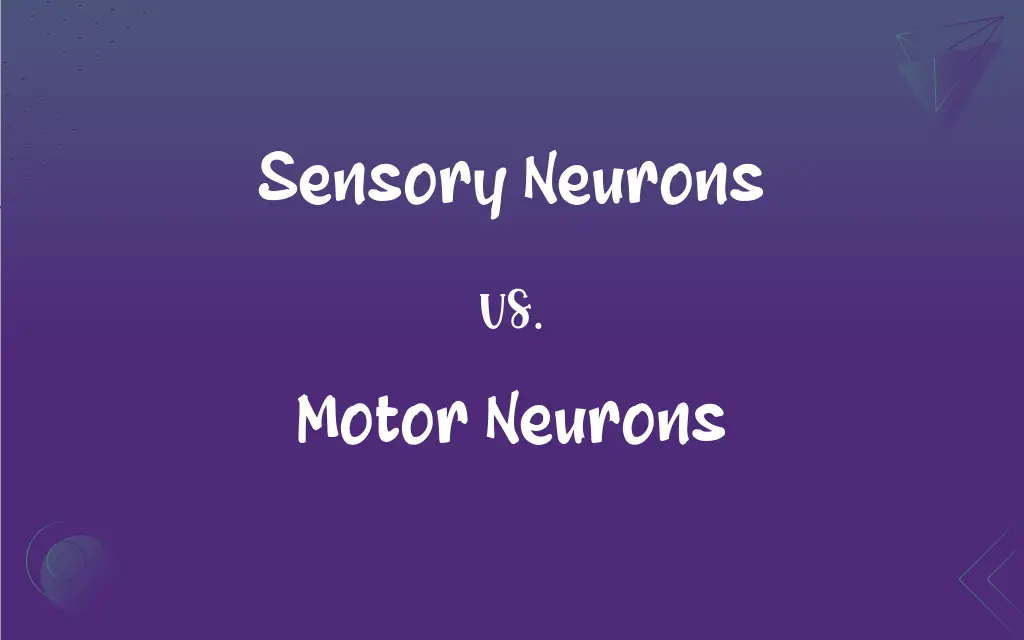Sensory Neurons vs. Motor Neurons: What's the Difference?
Edited by Janet White || By Harlon Moss || Updated on October 16, 2023
Sensory neurons transmit information from sensory receptors to the central nervous system, while motor neurons convey signals from the central nervous system to muscles and glands.

Key Differences
Sensory neurons play a crucial role in how organisms perceive and interact with their environment. They are responsible for transmitting information from external and internal stimuli to the central nervous system (CNS). For instance, when you touch a hot object, it's the sensory neurons that carry the sensation of heat to your brain. On the other hand, motor neurons have a different function. They are tasked with transmitting signals from the CNS to effectors, such as muscles and glands, resulting in action.
For a clearer understanding, consider the reflex arc. When you accidentally touch a sharp object, sensory neurons relay this painful stimulus to the CNS. In response, the CNS, through motor neurons, instructs your muscles to pull your hand away. Thus, while sensory neurons are involved in feeling the pain, motor neurons drive the immediate action of withdrawing the hand.
Another distinction lies in their structure and location. Sensory neurons usually have long dendrites and short axons, and are often found in the peripheral nervous system. These neurons gather information from sensory receptors, such as those in the skin or eyes. In contrast, motor neurons have long axons and short or moderate dendrites and are located in the CNS or the peripheral nervous system, directing muscles or glands to respond.
Moreover, sensory neurons can be further classified based on the type of stimuli they respond to, such as thermoreceptors for temperature or photoreceptors for light. Motor neurons, on the other hand, are categorized based on which part of the body they control, like somatic motor neurons for skeletal muscles and autonomic motor neurons for internal organs.
Comparison Chart
Primary Function
Transmit information from sensory receptors to CNS.
Convey signals from CNS to muscles and glands.
ADVERTISEMENT
Role in Reflex Arc
Detect stimuli and send signals to CNS.
Receive instructions from CNS and trigger action in muscles or glands.
Structural Characteristic
Often have long dendrites and short axons.
Typically have long axons and short/moderate dendrites.
Location
Mostly in the peripheral nervous system.
Found in CNS or peripheral nervous system.
Further Classification
Based on stimuli type (e.g., thermoreceptors, photoreceptors).
Based on body part control (e.g., somatic, autonomic).
Sensory Neurons and Motor Neurons Definitions
Sensory Neurons
Neurons that process information from our environment.
Sensory neurons in the skin help us feel the softness of a fabric.
ADVERTISEMENT
Motor Neurons
Connect the CNS to muscles or glands for action.
The command to swallow involves the motor neurons directing throat muscles.
Sensory Neurons
Connect sensory receptors to the CNS.
Sensory neurons relay the feeling of cold when touching ice.
Motor Neurons
Play a pivotal role in voluntary and involuntary movements.
Thanks to motor neurons, I can dance to my favorite song.
Sensory Neurons
Detect external and internal stimuli.
Sensory neurons alerted me to the bright light shining in my eyes.
Motor Neurons
Responsible for controlling muscle contractions and glandular activity.
Motor neurons activate when I decide to take a step.
Sensory Neurons
Involved in the perception of pain, temperature, and touch.
After pricking my finger, the pain signal traveled via sensory neurons.
Motor Neurons
Drive responses based on sensory inputs and cognitive processes.
To type on a keyboard, motor neurons guide precise finger movements.
Sensory Neurons
Neurons responsible for transmitting sensory information.
The heat from the flame was sensed by my sensory neurons.
Motor Neurons
Neurons that relay signals from the CNS to effectors.
My motor neurons enabled me to grip the ball tightly.
FAQs
How do motor neurons affect our muscles?
Motor neurons transmit signals from the CNS to muscles, causing them to contract or relax.
What are sensory neurons responsible for?
Sensory neurons are responsible for transmitting sensory information to the CNS.
Are motor neurons involved in reflex actions?
Yes, motor neurons play a role in reflex actions, quickly directing muscles to respond.
How do sensory neurons transmit signals?
Sensory neurons transmit signals via electrical impulses through their axons.
Can sensory neurons detect all types of sensations?
Sensory neurons can detect various sensations, from temperature and touch to pain and light.
How do injuries affect sensory neurons?
Injuries can damage sensory neurons, potentially leading to numbness or loss of sensation.
Where are sensory neurons mainly located?
Sensory neurons are primarily located in the peripheral nervous system.
Do motor neurons only control muscles?
No, motor neurons control both muscles and glands.
Can motor neurons initiate action without sensory input?
While motor neurons often respond to sensory input, they can also act based on memory or cognitive decisions.
Do motor neurons work in isolation?
No, motor neurons often work in coordination with other neurons and systems for complex actions.
Which has a more complex structure, sensory or motor neurons?
Both sensory neurons and motor neurons have unique structures suited to their functions, neither being universally more complex.
Can sensory neurons stimulate motor neurons directly?
In reflex arcs, sensory neurons can directly stimulate motor neurons for a quick response.
What's the importance of motor neurons in daily activities?
Motor neurons enable a wide range of activities, from walking and speaking to breathing and digesting.
Are motor neurons essential for survival?
Many vital processes, like heartbeats and breathing, rely on motor neurons, making them crucial for survival.
Are sensory neurons essential for all five senses?
Yes, sensory neurons are integral to all five senses: sight, hearing, touch, taste, and smell.
Are there different types of sensory neurons?
Yes, sensory neurons can be classified based on the type of stimuli they respond to.
Are motor neurons involved in involuntary actions?
Yes, motor neurons play a role in both voluntary and involuntary actions.
How do sensory neurons and motor neurons interact?
Sensory neurons send information to the CNS, which processes it and, if needed, directs motor neurons to respond.
Do sensory neurons have a role in memory?
While sensory neurons relay information, it's the brain's processing and storage systems that contribute to memory.
Can diseases impact motor neuron functionality?
Yes, diseases like ALS (Amyotrophic Lateral Sclerosis) specifically target motor neurons, affecting movement.
About Author
Written by
Harlon MossHarlon is a seasoned quality moderator and accomplished content writer for Difference Wiki. An alumnus of the prestigious University of California, he earned his degree in Computer Science. Leveraging his academic background, Harlon brings a meticulous and informed perspective to his work, ensuring content accuracy and excellence.
Edited by
Janet WhiteJanet White has been an esteemed writer and blogger for Difference Wiki. Holding a Master's degree in Science and Medical Journalism from the prestigious Boston University, she has consistently demonstrated her expertise and passion for her field. When she's not immersed in her work, Janet relishes her time exercising, delving into a good book, and cherishing moments with friends and family.































































